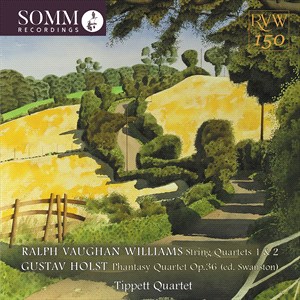

Ralph Vaughan Williams: String Quartet No. 2 in A minor Gustav Holst: Phantasy on British Folksongs, Op. 36 (ed. Swanston) Ralph Vaughan Williams: String Quartet No.1 in G minor
To the casual listening public, Ralph Vaughan Williams (1872-1958) is mostly remembered for his remarkable works for string orchestra which include the Fantasia on Greensleeves and the Fantasia on a Theme by Thomas Tallis, as well as his masterwork for violin and orchestra, The Lark Ascending. The more discerning classical music enthusiasts admire Vaughan Williams for setting the bar high for 20th century symphonic writing, with nine impressive symphonies. But all too often overlooked, is this composer's chamber music output, which when you include the rejected early compositions, amounts to around fifteen works.
Whilst it may be arguably easy to impress with orchestral works, what with all the various instrumental tone colours, superfluous notes, orchestral tuttis, etc ... the same can't be said about chamber music, most notably string quartets. Monochrome colours and textures, only four notes at once, limited dynamics. It's more difficult for a composer to hide shortcomings within a quartet. It's not simply a matter of assuring that all four musicians have notes to play. Each and every note is as valuable as the next, and must come together to form a cohesive, comprehensive and musical whole.
Separated by more than 30 years, these two quartets couldn't be any more different. The String Quartet No.1 in G minor (1909 - revised 1922) has a sort of pastoral feel to it. Its evocative slow movement in particular, which intensifies its emotional grip as it moves along only to sadly fade away in the end, is very well projected by the Tippett Quartet. The ardency and commitment in their playing much reminds me of their fine interpretation of the string quartet by another British composer, Donald Tovey.
In comparison, the String Quartet No. 2 in A minor from 1943, is characterized by an aggressive, tormented energy. Its highly agitated Scherzo movement paints surreal imagery, almost spectral in nature, pointing forward to his disturbing Symphony No. 6. I like the way the members of the Tippett Quartet alter the tonal qualities of their instruments to emphasize this effect. The somewhat peaceful and resigned final movement belies the fact that this music was conceived during a time of war. In my edition of the Penguin Guide to Recorded Classical Music only one older recording by the Maggini Quartet on the Naxos label is mentioned. Hopefully this new release by SOMM Recordings will pull these works out of the shadows and place them center stage.
Jean-Yves Duperron - September 2022